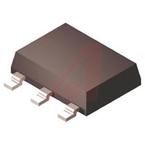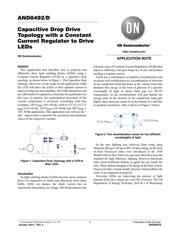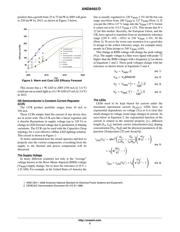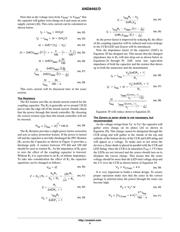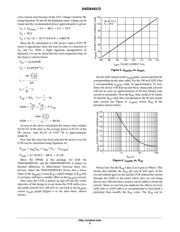下载

© Semiconductor Components Industries, LLC, 2013
January, 2013 − Rev. 2
1 Publication Order Number:
AND8492/D
AND8492/D
Capacitive Drop Drive
Topology with a Constant
Current Regulator to Drive
LEDs
ON Semiconductor
Abstract
This Application note describes how to properly and
efficiently drive light emitting diodes (LEDs) using a
Constant Current Regulator (CCR) in a capacitive drop
topology, as shown below in Figure 1. The Capacitive drop
topology allows for a wide range of end applications while
the CCR will drive the LEDs at their optimal current to
improve longevity and reliability. The LEDs themselves and
the LED market is explored as a lead into the justification for
this type of solution, the mathematical derivation of the
various components is reviewed, concluding with four
examples, 230 V
RMS
±6% 50 Hz, (100 to 127 V) 113.5 V
RMS
±12% 60 Hz, 120 V
RMS
±5% 60 Hz and 240 V
RMS
±
10% 50 Hz application. This application note will use the
+
and
–
superscripts to describe the maximum and minimum
values of the respective variable.
Figure 1. Capacitive Drop Topology with a CCR to
Bias LEDs
Introduction
As light emitting diodes (LEDs) become more common
place it is imperative to safely and effectively drive these
LEDs. LEDs are diodes, the diode current has an
exponential dependence on voltage. ON Semiconductor has
released a line of Constant Current Regulators (CCRs) that
improve efficiency and gain longevity of any end product
needing a constant current.
LEDs use a combination of radiative recombination and
localized well modification for recombination of electrons
in the conduction band and holes in the valence band that
dissipate this energy in the form of photons of a specific
wavelength of light in direct band gap (i.e. III−IV
compounds). As the recombination well gets thinner the
energy state of the electron in the conduction band gets
higher since electrons cannot be at the bottom of a well due
to quantum mechanics. This is shown in Figure 2 below.
Figure 2. Two recombination zones for two different
wavelengths of light
In the past lighting was achieved from using lamp
filaments that give off up to 80% of their energy in the form
of heat. Florescent tubes were introduced to the 1939
World’s Fair in New York City and since then have been the
standard for high efficiency lighting. However florescent
tubes need inefficient ballasts to ignite the gas inside the
tube. These ballasts dissipate a lot energy in the form of heat.
Florescent tubes contain deadly mercury which pollutes the
earth, if not disposed of properly.
Everyday LEDs are improving the amount of light
(lumens [lm]) they output per watt (W) of power. The US
Department of Energy (February 2010 R + D Workshop)
http://onsemi.com
APPLICATION NOTE

